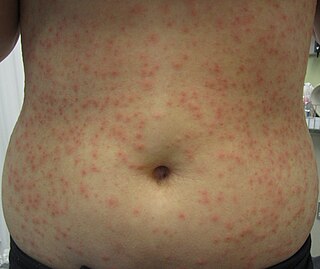Related Research Articles

Pili multigemini, also known as "compound hairs," is a malformation characterized by the presence of bifurcated or multiple divided hair matrices and papillae, giving rise to the formation of multiple hair shafts within the individual follicles.

Tinea barbae is a fungal infection of the hair. Tinea barbae is due to a dermatophytic infection around the bearded area of men. Generally, the infection occurs as a follicular inflammation, or as a cutaneous granulomatous lesion, i.e. a chronic inflammatory reaction. It is one of the causes of folliculitis. It is most common among agricultural workers, as the transmission is more common from animal-to-human than human-to-human. The most common causes are Trichophyton mentagrophytes and T. verrucosum.

Acne keloidalis nuchae is a destructive scarring folliculitis that occurs almost exclusively on the occipital scalp of people of African descent, primarily men.
Traction alopecia is a form of alopecia, or gradual hair loss, caused primarily by pulling force being applied to the hair. This commonly results from the sufferer frequently wearing their hair in a particularly tight ponytail, pigtails, or braids. It is also seen occasionally in long-haired people who use barrettes to keep hair out of their faces. Traction alopecia is recession of the hairline due to chronic traction, or hair pulling, and is characterized by a fringe along the marginal hairline on physical exam. Even though this "fringe sign" is considered a useful clinical marker of this condition, cases of frontal fibrosing alopecia presenting with an unusual retention of the hairline have been described.
Eosinophilic folliculitis is an itchy rash with an unknown cause that is most common among individuals with HIV, though it can occur in HIV-negative individuals where it is known by the eponym Ofuji disease. EF consists of itchy red bumps (papules) centered on hair follicles and typically found on the upper body, sparing the abdomen and legs. The name eosinophilic folliculitis refers to the predominant immune cells associated with the disease (eosinophils) and the involvement of the hair follicles.
The term acne cosmetica refers to acne caused by or aggravated by cosmetics. The mechanism is thought to be chemically induced plugging of the pilosebaceous orifice. This became a significant problem for dermatologists in the 1970s and 1980s, but with the improved formulations produced by cosmetic chemists in the decades since, a diagnosis of acne cosmetica has become relatively rare in dermatological practice.

Hot tub folliculitis is a common type of folliculitis, a condition which causes inflammation of hair follicles.
Steroid folliculitis occurs following administration of glucocorticoids or corticotropin. Other medications can also mimic these in order to cause a similar presentation.
Dissecting cellulitis of the scalp, also known as dissecting folliculitis of the scalp, perifolliculitis capitis abscedens et suffodiens of Hoffman, perifolliculitis abscedens et suffodiens, or folliculitis abscedens et suffodiens, is an inflammatory condition of the scalp that can lead to scarring alopecia, which begins with deep inflammatory nodules, primarily over occiput, that progresses to coalescing regions of boggy scalp. Boggy tissue has a high fluid level that results in a spongy feeling. Isotretinoin proves to be the medicine of choice for the treatment of the disease.

Lupus miliaris disseminatus faciei , also known as acne agminata, is a disease with a similar appearance to acne vulgaris. The cause of LMDF is unknown.

Folliculitis decalvans is an inflammation of the hair follicle that leads to bogginess or induration of involved parts of the scalp along with pustules, erosions, crusts, ulcers, and scale. It begins at a central point and spreads outward, leaving scarring, sores, and, due to the inflammation, hair loss in its wake. No permanent cure has been found for this condition, but there is promise in a regimen of dual therapy with rifampin 300 mg twice daily and clindamycin 300 mg twice daily. This new treatment can be used to control the condition, and tests have indicated that after 3 to 5 months long uninterrupted courses of treatment, many patients have seen limited to no recurrence.
Acquired perforating dermatosis is clinically and histopathologically similar to perforating folliculitis, also associated with chronic kidney failure, with or without hemodialysis or peritoneal dialysis, and/or diabetes mellitus, but not identical to Kyrle disease.
Disseminate and recurrent infundibulofolliculitis, also called disseminate and recurrent infundibular folliculitis or Hitch and Lund disease, is a rare follicular skin condition that presents with irregularly shaped papules pierced by hair, is mildly itchy at times, and is chronic with recurrent exacerbations.
Alopecia mucinosa is a skin disorder that generally presents, but not exclusively, as erythematous plaques or flat patches without hair primarily on the scalp, neck and face. This can also be present on the body as a follicular mucinosis and may represent a systemic disease.

Pityrosporum folliculitis is a skin condition caused by infection by Pityrosporum yeast.
Superficial pustular folliculitis is a superficial folliculitis with thin-walled pustules at the follicular openings.

Sycosis vulgaris is a cutaneous condition characterized by a chronic infection of the chin or bearded region. The irritation is caused by a deep infection of hair follicles, often by species of Staphylococcus or Propionibacterium bacteria. Asymptomatic or painful and tender erythematous papules and pustules may form around coarse hair in the beard or the back of the neck.
Eosinophilic pustular folliculitis of infancy is a cutaneous condition characterized by recurrent pruritic crops of follicular vesiculopustular lesions.
Lupoid sycosis is a cutaneous condition that is characterized by a scarring form of deep folliculitis, typically affecting the beard area.
References
- ↑ James, William; Berger, Timothy; Elston, Dirk (2005). Andrews' Diseases of the Skin: Clinical Dermatology. (10th ed.). Saunders. ISBN 0-7216-2921-0.
- ↑ Rapini, Ronald P.; Bolognia, Jean L.; Jorizzo, Joseph L. (2007). Dermatology: 2-Volume Set. St. Louis: Mosby. p. 1001. ISBN 978-1-4160-2999-1.
| This condition of the skin appendages article is a stub. You can help Wikipedia by expanding it. |